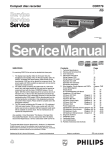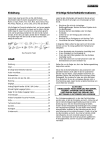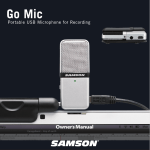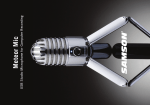Download Samson AL1 Network Router User Manual
Transcript
0 -10dB MICROPHONES Multi-Pattern Studio Condenser Microphone PROFESSIONAL C03 dB -10 0 Table Of Contents Introduction C03 Features Operating the C03 Powering the C03 Setting up the Signal Level Using the PAD Using the HI-PASS Polar Patterns Cardioid Omni Figure-8 Microphone Placement P-Popping Stand Mounting 3 3 4-6 4 4 4 4 4 5 5 5 6 6 6 Using the Optional SP01 “Spider” Shock-Mount 7 Specifications 8 Copyright 2003, Samson Technologies Corp. Printed March, 2003 Samson Technologies Corp. 575 Underhill Blvd. P.O. Box 9031 Syosset, NY 11791-9031 Phone: 1-800-3-SAMSON (1-800-372-6766) Fax: 516-364-3888 www.samsontech.com A K-TEAM P R O D UCTION Introduction and Features Introduction Congratulations on your purchase of the Samson C03 multi-pattern, studio condenser. The C03 features dual large, 19mm ultra thin diaphragm capsules which faithfully reproduce a variety of sound sources including vocals, acoustic instruments and overhead cymbals to name a few. And to expand your miking options and recording techniques, the C03 features three pickup patterns. The Cardioid pattern is great for miking applications where tight pickup is desired, and with the Omni and Figure 8 patterns you can mic multiple instruments, capture room sounds and expand your soundfield. The extended frequency and fast transient response insures an accurate reproduction with linear characteristics from bottom to top. In these pages, you’ll find a detailed description of the features of the C03 Studio Condenser Microphone, as well as step-by-step instructions for its setup and use, an explanation of the variable pick-up patterns and full specifications. You’ll also find a warranty card enclosed—please don’t forget to fill it out and mail it in so that you can receive online technical support and so we can send you updated information about these and other Samson products in the future. With proper care and adequate air circulation, your C03 will operate trouble free for many years. We recommend you record your serial number in the space provided below for future reference. Serial number: Date of purchase: Should your unit ever require servicing, a Return Authorization number (RA) must be obtained before shipping your unit to Samson. Without this number, the unit will not be accepted. Please call Samson at 1-800-3SAMSON (1-800-372-6766) for a Return Authorization number prior to shipping your unit. Please retain the original packing materials and if possible, return the unit in the original carton and packing materials. C03 Features • Large diaphragm, multi-pattern studio condenser microphone. • Dual 19mm capsules with 3-micron diaphragm. • Smooth and transparent sound reproduction from bottom to top. • Super Cardioid, Omni and Figure 8 pickup patterns provide versatility in covering a variety of miking applications. • Switchable 10 dB PAD for handling signals with high SPL’s (Sound Pressure Levels). • Switchable Hi-pass Filter, 12dB per octave at 100 Hz. • 36-52 Volt Phantom Power operation with Blue LED. • Internal Shock-mounted capsules. • Extended frequency response. • Solid Die Cast construction. • Swivel Stand Mount and Carry Case included. Operating the C03 Powering the C03 The C03 is a condenser microphone and therefore needs to be operated by connecting a phantom power supply. Phantom power is standard on most quality mixers, outboard micpres and hard disk recorders. If necessary, an external phantom supply (like the S phantom by Samson Audio) can also be used. The C03 receives the phantom power directly from a mic cable when connected to a mixer or other microphone input that includes a phantom supply. The power is actually sent OUT of the microphone INPUT, riding silently along with the audio signal. (Fairly mysterious, eh?) Most mixers have a switch to engage the phantom power so be sure to check that the phantom power is on. The C03 features a blue LED, which will illuminate when phantom power is present. Setting Up the Signal Level When connecting the C03 to a mixer or recorder input, be sure that the input is of microphone level. Also, be sure that the phantom power is engaged as explained the previous section “Powering the C03”. Most mixers and recorders of reasonable quality will offer a microphone input with mic trim (usually called Trim or Gain) control. The purpose of the mic trim control is to optimize the amount of good signal to any noise associated with the mixers electronics. A good mic pre with trim also will have a PEAK or CLIP LED. To set a good level on the mic, set the C03 up in front of the desired sound source and slowly raise the mic trim control until you see the PEAK LED light up. Then, turn the mix trim control down until the LED does not light any more. On most mixers, the ideal setting is that the trim control is turned up as much as possible without lighting the PEAK LED. If you try turning the Gain control all the way down, and the PEAK light is still lighting, try using the C03’s PAD as explained in the following section. 1 Using the PAD Switch The C03 includes a PAD switch, which you can use to lower the input sensitivity of the microphone. When the PAD switch is set at the 0dB position the PAD is bypassed and there is no effect on the signal. When the PAD switch is set to the –10dB posi1 tion, the microphone’s input sensitivity will be lowered by 10dB. You can use the PAD when you are miking loud sound sources with a high SPL (Sound Pressure Level). 2 Using the Hi-Pass Filter The C03 offers a user selectable hi-pass, or low-cut filter, which you can use to eliminate any unwanted low frequency reproduction. When the Hi-pass Filter is is set to the “flat” (indicated by the straight line) position, there is no effect on the signal. When the Hi-pass switch is set to the “roll-off” position (indicated with the angled line), a 12dB per octave low2 cut at 100Hz is applied to the signal. This can be extremely useful for removing low frequency stage rumble, wind noise during outdoor use, and filtering out lows from drums when used as overhead cymbal microphone on a drum kit. Polar Patterns The most important characteristic of any microphone is its directionality or “pickup pattern”. The C03’s versatile dual capsule design is capable of producing three useful pick up patterns; Cardioid, Omni, and Figure 8. It is easy for you to select the pickup pattern using the C03’s pattern selection switch located on the rear of the microphone. When choosing a pattern, you should be aware of the phenomenon known as the “proximity effect”. 4 Operating the C03 Simply put, proximity effect is the change in frequency response as the microphone position is changed relative to the sound source. Any microphone exhibits its best frequency response when pointed directly at the sound source (on-axis). Depending on the pickup pattern, the low frequency response will increase, sometimes greatly, when positioned less than 12 inches away from the sound source (off-axis). Understanding and knowing how to use the proximity effect can be a tremendous help in getting just sound you looking for. The following sections details the three available pickup patterns. 3 Super Cardioid While Omni and Bi-directional microphones are very useful for a variety of specialty applications, the majority of miking situations in recording and live sound require uni-directional or Cardioid microphones. The C03 condenser’s pickup pattern is 3 Super-cardioid, which offers even more side-to-side rejection. The uni-directional nature allows for better separation of instruments in the studio and more control over feedback in live sound reinforcement. To select the Super Cardioid pickup pattern, set the pattern selection switch to the center, Super Cardioid position indicated by the “heart shaped” icon. When positioned correctly, the Super-cardioid pickup pattern allows you to pick up more of the sound you want and less of the sound you don’t want. 4 Omni Omni, or omni-directional, microphones pick up sound from all directions. To select the Omni pickup pattern, set the C03’s pattern selection switch to the right, “O” position. You can use the omni pickup pattern if you want to capture the ambient sound and 4 natural reverb in a room where an instrument or voice is being recorded. The Omni mode is also great for recording ensemble performances from groups of vocals, brass, woodwind and other instruments with the artists facing each other in a circle around the microphone. As an added benefit, the omni pattern is the least susceptible to the proximity effect. This can be extremely useful when recording artists who have a tendency to move their instrument, including their voice, around the microphone while performing. In these situations, using a cardioid pattern can result in the frequency response changing tremendously with just a few inches of movement resulting in a recorded track with the lows moving up and down in volume. Using the omni pick up pattern can help control these tricky miking situations allowing you to capture the best performance without inhibiting the talent by forcing them to try to stay in a fixed position. 5 Figure 8 Figure 8, or bi-directional, mics pick up the sound directly in front and back of the microphone while rejecting the sound on the left and right sides. To select the Figure-8 pickup pattern set the C03’s pattern selection switch to the left, “8” position. In this 5 mode it’s almost like having two identical microphones facing back-to-back to each other. This can be an ideal setting for capturing two artists singing a duet or laying down a background vocal track. Having the two artists face each other while performing can help capture the emotions that may other wise be missed if two microphones are used. You can also create some interesting slap back echo effects by positioning the C03 in Figure-8 pattern between a recorded instrument and a particular wall in the studio. The rear capsule will pick up the reflection of the sound off the wall, and by changing the distance of the microphone from the wall you can actually change the delay time of the echo. 5 Operating the C03 Microphone Placement In order to maximize the sound quality, you must pay careful attention to the placement of your C03 and how it is positioned for the instrument or vocalist that you are miking. All microphones, especially uni-directional or cardioid microphones, exhibit a phenomenon known as the “proximity effect.” Very simply put, proximity effect is a resulting change in the frequency response of a microphone based on the position of the mic capsule relative to the sound source. Specifically, when you point a cardioid mic directly at the sound source (on axis) you will get the best frequency response, however when you start pointing the microphone slightly away (off axis) you will notice the low frequency response dropping off and the microphone will start to sound thinner. For most vocal applications you’ll want to position the microphone directly in front of the artist. The same may be true for miking instruments, however, you can make some pretty amazing equalization adjustments by slightly changing the angle of the capsule to the sound source. This can be a very useful technique in capturing the optimum sound of drum set, acoustic guitar, piano or other instruments in a live room or sound stage. Experimentation and experience are the best teachers in getting good sounds, so plug in! P-Popping P-Popping is that annoying pop that you can get when the microphone diaphragm gets a blast of air from a vocalist pronouncing words with the letter “P” included. There are a few ways to deal with the problem including using an external pop filter. Some famous engineers have relied on an old nylon stocking over a bent clothes hanger, which actually works very well. (For a cleaner solution, try a PS01 pop filter from Samson Audio.) You can also try placing the microphone slightly off axis (on a slight angle) from the vocalist. This can often solve the problem without using an external pop filter. Stand Mounting the C03 The C03 can be mounted to a standard microphone stand using the included swivel mount adapter. If you are using a U.S. 5/8” mic stand, you will need to remove, by unscrewing, the Euro stand adapter. Simply screw on the swivel adapter to your mic stand or boom arm. Now, loosen the thumbscrew and adjust the microphone to the desired angle. Once set, tighten the thumbscrew to secure the microphone in place. 6 Using the Optional SP01 Shock-Mount Using the Optional SP01 “Spider” Shock-Mount For additional isolation, the C03 can be fitted on the optional SP01 “Spider” shock mount. Follow the steps below the to install the SP01. 1 0 • First, screw the SP01 shock mount onto your mic stand or boom arm. If you’re using a US 5/8” mic stand or boom, remove the Euro adapter. • Remove the C03 swivel mount by rotating the threaded collar counterclockwise as shown in figure 1. • Install the C03 into the SP01 by fitting the microphone into the center of the web, positioning the C03 onto the bottom mounting plate. • • Secure the SP01 by reinstalling the threaded collar, rotating clockwise until tight. (Figure 2) Now, loosen the thumb screw to adjust the angle of the microphone and position the C03 to the desired location. Once set, tighten the thumbscrew to secure the microphone in place. -10dB THREADED COLLAR 2 0 -10dB SP01 SHOCK MOUNT Note: Be careful not to cross thread or over tighten the threaded collar or thumb screw. THUMB SCREW THREADED COLLAR 7 C03 Specifications Specifications Type Polar Pattern Frequency Response Sensitivity Rated Impedance Equivalent Noise level Max. SPL Dynamic Range Power Supply Current Consumption Dimensions Weight Condenser Microphone Super Cardioid/Fig. 8/Omni 40~18000 Hz -40 dBV/pa (10mv/pa) 350Ω 23 dB (A weighted IEC/DIN 651) 142 dB (THD≤ 0.5% 1000 Hz) 119 dB 48V Phantom Power (IEC 26815/DIN 45596) 7.0 mA ø 54 x 180 mm 460g Specifications subject to change without notice. Samson Technologies Corp. 575 Underhill Blvd. P.O. Box 9031 Syosset, NY 11791-9031 Phone: 1-800-3-SAMSON (1-800-372-6766) Fax: 516-364-3888 www.samsontech.com



















